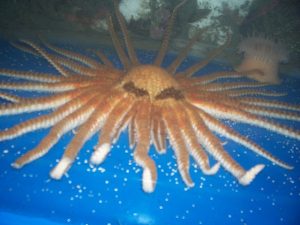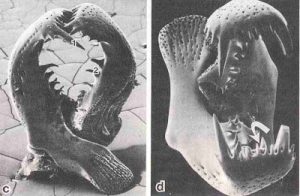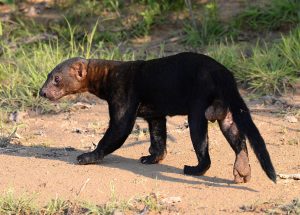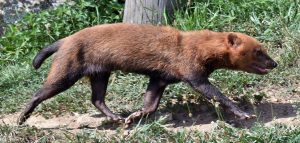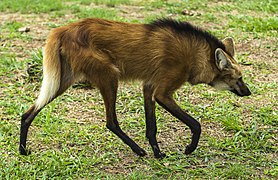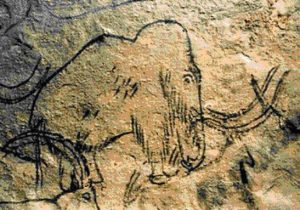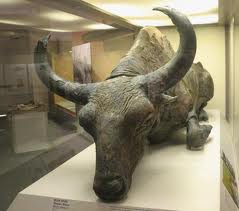Podcast: Play in new window | Download (Duration: 8:25 — 9.4MB)
Apologies to patrons for redoing an old Patreon episode, but I have a cold and it’s the holidays.
The noble emu:
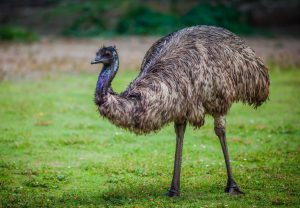
A baby emu (picture from this site, which has lots of good info about emus and lots more great pictures):
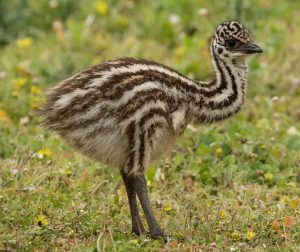
Show transcript:
Welcome to Strange Animals Podcast. I’m your host, Kate Shaw.
I had a different episode planned to finish off the year, but I had lots of stuff to do for the holidays so I put it off, and then I came down with a cold. It’s just a cold, at least, and it’s not too serious, but I decided to repurpose a Patreon episode from early 2020 instead of making a new episode, because I don’t feel good. Apologies to my patrons for getting a rerun, but I did give the episode a brush-up and re-recorded it.
Our topic this week is a bird from Australia, the emu, but mostly we’re going to learn about the emu war that happened in 1932.
The emu is a large, flightless bird almost as big as an ostrich, over 6 feet tall, or 2 meters. Like the ostrich, it can run really fast, over 30 miles per hour, or 50 km/hour. It’s only distantly related to the ostrich, though, and in fact it’s much more closely related to the tiny kiwi of New Zealand.
The emu has long legs and a long neck, soft feathers that are gray and brown, and three toes on each foot. It also has small vestigial wings that are only about eight inches long, or 20 cm. The body feathers make the emu look shaggy, but the head and the upper portion of the neck are less heavily feathered so that it sort of looks like it’s wearing a fancy coat with a high collar. It also looks like it has a poofy wedge of a downward-pointing tail, but it actually doesn’t have much of a tail at all. What looks like a tail is mostly part of the body. The emu’s skeleton is built for running, which includes a modified pelvis and leg bones for the attachment of strong leg muscles.
In winter, the female puffs out her feathers and struts around to attract a mate while making drumlike calls. Females sometimes fight each other by kicking, especially if a female approaches a male who already has a mate. The male builds a nest on the ground by placing dry grass, sticks, bark, and other plant materials on a flat, open area where he can see any predators that might approach.
The female lays up to 15 green eggs that are around five inches long, or 13 cm. The male broods the eggs for the next eight weeks and doesn’t eat during that entire time, and only drinks whatever dew he can gather from the plants around the nest without leaving the nest. A male can lose a third of his weight while brooding. Meanwhile, the female often leaves and finds another mate, sometimes laying several clutches of eggs during the nesting season.
When the babies hatch, the father takes care of them for the next six or seven months, at which point they’re fully grown. While he’s in charge, the father won’t let any other emus near the chicks, even their mother. He teaches them to find food and if the babies feel threatened, they’ll run underneath him to hide. Baby emus have gray and white longitudinal stripes and are super cute.
The emu eats plants and insects, and will sometimes travel long distances to find enough food and water. It can go a long time without eating and several days without drinking. It usually only drinks once a day but it will drink a whole lot of water during that one time.
Some populations of emu migrate to the coast after breeding season, where they can find more food and cooler weather. But in 1932 in western Australia, migrating emus didn’t find their usual food supplies. They found a whole lot of wheat fields cultivated by former soldiers, who had been given land after World War I. The Australian government had encouraged the soldiers to clear the land of native vegetation and grow lots of wheat, which they did. Then the emus showed up.
Naturally, without their usual food to eat, the emus sampled the wheat plants. And they found the plants yummy. Also, even though there was a drought that year, there was plenty of water for the wheat, which meant plenty of water for emus. So the emus showed up and showed up and showed up, an estimated 20,000 emus eating as much wheat as they could hold and crashing through fences to get to it.
The farmers sent a group to speak to the Minister of Defence to get help. The Minister of Defence sent a major with a small handful of soldiers to deal with the birds, with the soldiers armed with two lightweight machine guns.
On November 2, 1932, the men encountered their first emus. The birds were too far away to shoot so the men tried to herd them closer, but the emus scattered instead of staying in a group. Two days later, the men encountered approximately a thousand emus and lay in wait until the birds were close enough to shoot at–but the gun jammed and the birds scattered again. At this point the soldiers had killed maybe two dozen birds in all.
That was enough that the emus had figured out the men were a danger. The men reported that each group of birds now had a lookout. The rest of the flock would eat while the lookout kept watch. When the lookout spotted the men, it warned the others and all the emus would scatter.
The men even tried mounting a machine gun on a truck to run the emus down. But the ground was too bumpy to aim while the truck was moving, plus it couldn’t outrun the emus. On one occasion a dead emu got tangled in the steering equipment and the truck crashed into a fence, destroying both the truck and the fence.
On November 8, the men were withdrawn after having only killed around 200 emus, but they’d used a quarter of the ammunition they’d been allotted to do that. One politician suggested sarcastically that the soldiers deserved a medal for their part in the war, and another politician pointed out that the medal should properly go to the emus.
But the emus were still a problem, so after more entreaties from farmers, the same men and guns were sent back to try again. They kept at it for the next month or so and did manage to kill maybe a few thousand birds, but for every bird they killed, they shot ten bullets. Finally they were recalled for good. The government put a bounty on dead emus instead, and the farmers put up larger and stronger fences. It wasn’t until the late 1960s that the bounty was canceled and the emu protected. The current population is large and healthy.
There used to be several smaller subspecies of emu, but they went extinct basically as soon as Europeans showed up. We’re lucky that the mainland emu survived the war and the bounty hunting so that we can appreciate it today.
You can find Strange Animals Podcast at strangeanimalspodcast.blubrry.net. That’s blueberry without any E’s. If you have questions, comments, or suggestions for future episodes, email us at strangeanimalspodcast@gmail.com. We also have a Patreon at patreon.com/strangeanimalspodcast if you’d like to support us for as little as one dollar a month and get monthly bonus episodes.
Thanks for listening!
